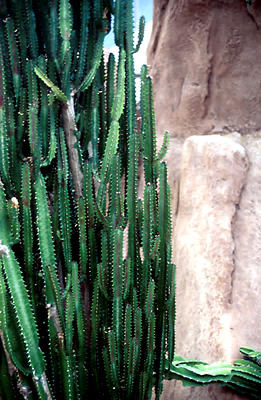| Description | A tall, vertical Euphorbia that is many times mistaken for a cactus. |
|---|---|
| Pronunciation | (yoo-FOR-bee-uh)(try-GOH-nuh) |
| Plant Type | All Plants, Succulents |
| Hardiness Zone | 9-11 |
| Sunlight | full sun, direct |
| Moisture | dry out between watering |
| Soil & Site | average, well drained |
| Growing Media | average house, well drained, cactus and succulent mix |
| Flowers | not ornamental |
| Leaves | spines |
| Stems | 3-4 angled, wing like stem lined with spines |
| Dimensions | +12' tall |
| Propagation | This plant can be rooted from stem cuttings. As is with almost all of the Euphorbia when you take the cutting the plant will bleed a sticky, white sap (not a good substance to get into the eyes, cuts or sensitive skin). The cuttings have rooted best during the hotter parts of the year....Take the cutting... let it callus for a day or so....I use perlite to root it in....bury the cutting in the perlite 2-3 or more inches depending on the size of the cuttings...use a layer of coarse rock to add support to the plant and weight to the pot so the cutting won't tip....with perlite the chance of over watering is almost eliminated...put in a moderate light area and keep warm...this has worked for me...be patient. |
| Native Site | Tropical West Africa, Gabon, Southwest Africa |
| Misc Facts | Euphorbia are commonly called cactus. When in reality all cactus belong to the Cactaceae family and are native to North American, Central America and South America. All Euphorbia are in the very large, diverse Euphorbiaceae family and are found native in Africa, Asia, etc. Genus name honors Greek physician Euphorbus of the first century A. D. |
| Notes & Reference | #229-Euphorbias A gardeners Guide (Rodger Turner), #230-Euphorbias (Timothy Walker) |

Cart

